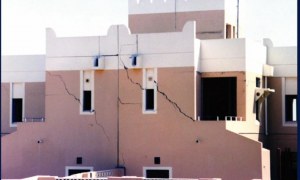🕑 Reading time: 1 minute
Soil liquefaction is the phenomenon in which the stiffness and the strength of the soil are lost under the action of earthquake force or due to rapid loading conditions. Soil liquefaction occurs in a fully saturated soil.Contents:
Principle and Causes of Liquefaction
The soil in normal condition is closely packed to each other. The soil particles are closely packed due to the contact forces of each particle. This tight packing contributes to the soil strength. When the soil is in the saturated condition, the pores and the soil are fully filled with water. These water molecules present in the soil exerts pressure on the neighboring particles. The water pressure exerted by these water molecules increases with rapid load action or earthquake forces. During liquefaction, the water pressures become high enough to counteract the gravitational pull on the soil particles. This is explained in figure-1 and figure-2 below. The figure-1(a) shows the soil particles present in the unexcited state. The blue column in the right shows the magnitude of pore water pressure in the soil sample.
Fig.1. The Soil Grain Condition in Unexcited State

Fig.2.Soil Grain Condition at Fully Saturated Condition
Effects of Liquefaction
Liquefaction phenomenon can result in many effects in the soil and the structures. They are:1. Sand Boiling
When liquefaction occurs below the surface that is fully compacted, the water pressure below the surface makes the water to break out like a bubble. These come out as boiling water. This is called as sand boiling.2. Damage to offshore structures
Liquefaction is common in soil that is submerged. These conditions cause huge damage for the bridge construction, structures supporting submerged soil deposits.3. Failure of Dams and Retaining Walls
The soils supporting Dams and Retaining walls undergoes liquefaction, which results in the collapse of these structures. As the structures lose the ability to control the huge water it further results in floods that are uncontrollable.4. Surface Landslides
The failure of water carrying bodies can result in surface landslides.5. Failure of Structures under Earthquake
Liquefaction followed by earthquake forces make the structures to lose its stability. They can either split or lean bringing complete collapse of the structure. Past earthquake records have shown a huge failure of building structures due to liquefaction. These hazards do not provide enough time for evacuation that it results in a huge loss of life and property. Read More: Effect of Soil Liquefaction on Pile FoundationImportance of Soil Liquefaction
After Liquefaction, the soil no longer behaves as an inactive grid of particles. The strength and stiffness of the liquefied soil are significantly decreased, often resulting in a variety of structural failures.H ence, a liquefied ground is no longer considered stable and fit for construction of structures. It has no ability to take even its self-weight nor weight of structures above. The building structures constructed over such a deposit type lean and fall as shown in figure-4 below.
Fig.4.Failure of Building Structure Due to Soil Liquefaction, Liquifaction in Izmit, Turkey
Methods of Reducing Soil Liquefaction Hazards
There are basically three methods of reducing liquefaction hazards:1. By Avoiding Liquefaction Susceptible Soils
Construction on liquefaction susceptible soils is to be avoided. It is required to characterize the soil at a particular building site according to the various criteria available to determine the liquefaction potential of the soil in a site
Fig.5. Earthquake-induced liquefaction


